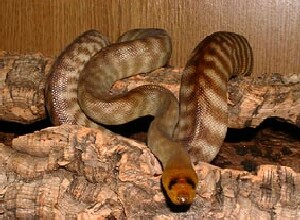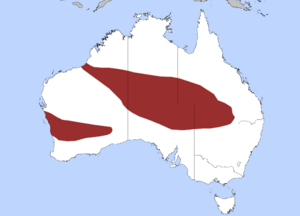Woma python facts for kids
Quick facts for kids Woma python |
|
|---|---|
 |
|
| Conservation status | |
| Scientific classification | |
| Genus: |
Aspidites
|
| Species: |
ramsayi
|
 |
|
| Distribution of the woma | |
| Synonyms | |
|
|
The woma python (Aspidites ramsayi) is a special type of snake. People also call it Ramsay's python, the sand python, or just the woma. It belongs to the python family and lives only in Australia.
Woma pythons used to be common across Western Australia. But now, in some areas, they are in great danger.
Contents
About the Woma Python Name
The woma python was first described in 1882 by William John Macleay. He gave it the name Aspidiotes ramsayi. The second part of its scientific name, ramsayi, honors an Australian animal expert named Edward Pierson Ramsay.
The woma python is one of two species in the Aspidites group. This group is special because these pythons do not have heat-sensing pits. The name Aspidites means "shield bearer." This refers to the shield-like scales on their heads.
What Woma Pythons Look Like
Adult woma pythons usually grow to be about 1.5 meters (4.5 feet) long. Some can even reach up to 2.3 meters (about 7.5 feet). They have a narrow head and small eyes.
Their body is wide and somewhat flat. Their tail gets very thin towards the end. They have small, smooth scales all over their body. The scales on their back can be light brown to almost black.
The main color of their body can be brown, olive, orange, pink, or red. They have darker stripes or blotches on top of this color. Their belly is usually cream or light yellow with brown and pink spots. The scales around their eyes are often darker than the rest of their head.
Woma pythons look a bit like the black-headed python. But womas do not have a clear neck. It is important not to confuse them with the venomous gwardar snake, which looks similar.
Where Woma Pythons Live
Woma pythons live in the western and central parts of Australia. You can find them from Western Australia through the southern Northern Territory and northern South Australia. They also live in southern Queensland and northwestern New South Wales.
They used to be common in sandy areas and farmlands in Southwest Australia. Sadly, their numbers have dropped a lot in these areas.
Protecting Woma Pythons
The woma python is listed as "Least Concern" by the IUCN. This means they are not currently in great danger worldwide.
However, many groups of woma pythons in Australia are critically endangered. This is because of changes in how land is used. For example, in the Wheatbelt areas, their numbers have sharply declined since the 1960s.
The Adelaide Zoo in South Australia is working to help these snakes. They have a program to breed woma pythons in captivity. Some young snakes have been released into a special reserve. But sadly, many were eaten by other snakes, like the mulga snake.
How Woma Pythons Behave
Woma pythons are mostly active at night. During the day, they like to hide in hollow logs or under piles of leaves.
When they move across hot sand, they have a special way of walking. They lift their body off the ground and reach far forward. Then they push off the ground again. This way, only a small part of their body touches the hot surface at a time.
What Woma Pythons Eat
Woma pythons eat many different animals that live on the ground. This includes small mammals, ground birds, and lizards.
They often catch their food in burrows. In these tight spaces, they cannot coil around their prey like other pythons. Instead, they push a loop of their body against the animal. This pins the prey against the side of the burrow. This method does not kill the prey as quickly as normal squeezing. Because of this, many adult womas have scars from rodents that fought back.
Even though they can eat warm-blooded animals, woma pythons mostly eat reptiles. This might be why they do not have the heat-sensing pits that other pythons have. They do have a similar sensory part on their nose.
Reproduction and Life Cycle
Woma pythons lay eggs. A female can lay between five and 20 eggs in one clutch.
After laying her eggs, the female stays coiled around them. She protects them until they hatch. The eggs usually take about two to three months to hatch. A female woma python, around 4 to 5 years old and 1.5 meters long, typically lays about 11 eggs.
Woma Pythons as Pets
Woma pythons are known to be more active than many other pythons. They are also very calm and easy to handle. Because of this, they are popular in the exotic pet trade.
They are one of the toughest python species to keep as pets. They often eat eagerly. In 2015, one woma python even needed surgery because it swallowed its feeding tongs along with its meal! Woma pythons can also breed in captivity.
Aspidites ramsayi at the TIGR Reptile Database. Accessed 19 September 2007.


